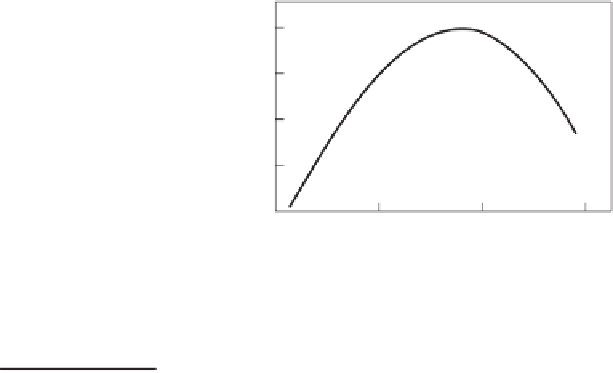Environmental Engineering Reference
In-Depth Information
rf
, where
f
is the rotational frequency of the turbine shaft.
19
component is 2
π
I
n the direction
of the turbine axis the wind speed is
V
t
. The net relative speed
V
rel
is thereby
V
t
2
,
+
(
2
π
rf
)
β
=
(
V
t
/
π
)
and this velocity lies at an angle
to the tangential direction, as shown in
Figure 7.16. The airfoil-shaped section of the turbine blade, pitched at a small angle of attack to this
direction, develops a lift force
L
and drag force
D
that are, respectively, perpendicular and parallel
to the direction of the relative velocity. The net force exerted on the blade section in the direction
of its motion is
L
sin
arctan
2
rf
, and the rate at which this force does work on the turbine, which
is the power developed by the wind, is thereby 2
β
−
D
cos
β
.
There are two important deductions that can be made from this analysis. The first is that it
is necessary that the airfoil lift
L
should greatly exceed its drag
D
, which can be secured by
utilizing efficient airfoil shapes in forming the turbine blades. The second is that the turbine power
is enhanced by turbine tangential speeds that are large compared to the wind speed, so as to come
as close as possible to the power limit of Equation (7.13). Optimum designs incorporate a speed
ratio (turbine tip speed/wind speed) of about five to seven.
The performance of a wind turbine may be described in terms of a dimensionless power
coefficient
C
p
defined as
π
fr
(
L
sin
β
−
D
cos
β)
P
C
p
≡
(7.14)
1
2
ρ
V
3
A
where
A
is the turbine rotor disk area. The power coefficient cannot exceed the ideal value of 16/27,
but is otherwise a function of the speed ratio, as sketched in Figure 7.17, reaching a maximum at the
design speed ratio. At lower speed ratios the airfoil angle of attack is too great and the aerodynamic
drag
D
increases greatly, reducing turbine power. At higher speed ratios, the airfoil angle of attack
decreases, reducing the lift
L
and also the turbine power.
An economical wind turbine design must take into account several factors. The power available
from the turbine and that delivered by the electric generator it drives is matched at the design wind
0.4
0.3
0.2
0.1
0
0
4
8
12
Tip speed/wind speed
Figure 7.17
The power coefficient of a wind turbine is a function of the ratio of the tip speed to wind speed.
Its maximum value is less than the theoretical value of 16
/
27
=
0
.
593.
19
Strictly speaking, the relative speed in the tangential direction is somewhat less than 2
π
rf
because the
blade tangential force induces a small amount of tangential flow. This is generally negligible for efficient wind
turbine designs.


